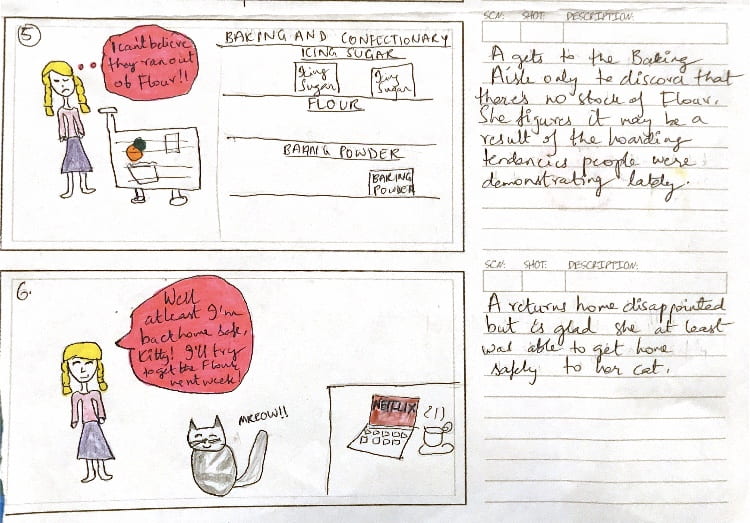
The Covid, Comics and Me Workshop introduced us to the concept of comics as a medium of conveying information. Although comics have varied histories and styles around the world, they are a cross-cultural media that is widely used in popular cultures. These characteristics make comics ideal for humanising statistics (Alberda and Feigenbaum 2020). Comics are relatable as they are the best combination of text and images and are portrayed in a format that is easy to understand. Another advantage of comics as an information tool is that the reader can actively choose how long they want to participate with it. Dix and Kaur (2019) emphasise on how comics don’t just describe people’s experiences but also serve as a tool to present sensitive data regarding violence, trauma and torture.
The workshop began with Dr Feigenbaum and Conor Byrne introducing us to Scripting and Storyboarding for comics. Scripting provides background information to the story and is a great method of organising ideas for the comic and setting the scene. It is also essential to identify and establish the characters in a comic. These could range from human and non-human characters such as animals or plants or events as characters, for example the tornado from the movie Twister would be a character.
An important step in comic-making is creating a Narrative arc. Freytag’s Pyramid provides a structure for the storyboard wherein the scene is set, followed by a complication that leads to a rising action and the climax of the story. The complication is then resolved by a falling action and the outcome of the plot is decided. Here is an example of a four-panel comic following the pyramid’s structure.


The Mini Masterclass was concerned with how to identify key points in our story for our comics and support them with related academic studies with relevant findings. In the example below by the artist Coronadiary, the comic touches upon the issues of mental health, childbirth and families being separated by the pandemic.

The final section of the workshop introduced us to the importance of Panels, Caption boxes and Communication Bubbles. Panels help break down the story into sections. They can either read from left to right or back to front, as seen in Manga comics. Captions are useful in setting the context of the images and the story. Communication bubbles help the characters in conveying the story. This can either be done through different forms of Speech such as screams and whispers or thoughts. In Gemma Corell’s comic below, the communication is done entirely through thought bubbles.

My Workshop Artefact
The comic I created for the workshop is a nine-panel one. It’s the story of the protagonist A, who while isolating at the beginning of the Covid-19 pandemic wants to bake to destress. While perusing through her pantry, A realizes that there is no flour, and she must go grocery shopping. She is apprehensive about having to go to the supermarket. A eventually does step out though and must wait in a queue to enter the supermarket. A gets to the Bakery aisle only to discover that there is no stock of flour. She is disappointed but returns home, determined to return soon. A few days later, A goes back to the supermarket and is excited to find the flour she wants. A bakes cinnamon rolls and is happy to have done so finally. Later that day, she calls her mother and tells her how she feels much better having made the cinnamon rolls. My comic highlights the importance of creativity and how it affected people’s well-being during the pandemic. Tang et al. (2021) discovered through their study that people benefit from participating in creative activities since it allows them to grow and have prosperous experiences.



In a variety of ways, creativity can help people feel more purposeful. Individuals were drawn not only to behaving creatively during the pandemic, but also to engage in the process of creation itself (Kapoor and Kaufman 2020). For example, in April 2020 and beyond, a major trend in middle to upper income households was the desire to bake sourdough bread or make dalgona coffee. Individuals felt the urge to express or distract themselves by making something. Creating something appears to have value, perhaps as a coping mechanism of dealing with uncertainty and handling ambiguity (Kapoor and Kaufman 2020). Although the covid-19 pandemic wreaked havoc in people’s everyday lives and challenged the worldwide economy, there exists scientific evidence to prove a positive relationship between creativity and the experience of crisis (Tang et al. 2021).
References:
Alberda, A and Feigenbaum, A., 2020. COVID-19 Comics and the Data Visualisation of Everyday Life. Unpublished.
Dix, B and Kaur, R., 2019. Drawing- Writing Culture: The Truth-Fiction Spectrum of an Ethno-graphic Novel on the Srilankan Civil War and Migration. Visual Anthropology Review [online], 35(1), 76-111.
Kapoor, H and Kaufman, J.C.,2020. Meaning-Making Through Creativity During COVID-19. Frontiers in Psychology [online], 11, e595990.
Tang, M, Hofreiter, S, Reiter-Palmon, R, Bai, X and Murugavel, V., 2021. Creativity as a Means to Well-Being in Times of COVID-19 Pandemic: Results of a Cross- Cultural Study. Frontiers in Psychology [online], 12, e601389.
